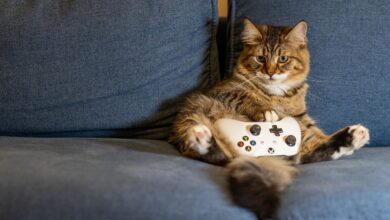
Cat positive reinforcement training is a wonderful way to build a strong and loving relationship with your feline companion while teaching them important behaviors and skills. In this guide, we’ll explore the world of positive reinforcement for cats, including how it works, why it’s effective, and how to apply it successfully in training your furry friend.
Table of contents
Understanding Cat Positive Reinforcement
Positive reinforcement for cats is a training method based on rewarding desired behaviors with things your cat loves. These rewards can be treats, verbal praise, pets, playtime, or any other positive experience your cat enjoys. The core principle is to create positive associations between behavior and reward, motivating your cat to willingly repeat the desired actions.
Why Cat Positive Reinforcement Works
- Motivational: Cats are naturally inclined to seek rewards, making positive reinforcement a motivating and enjoyable way for them to learn.
- Bond-Building: Positive reinforcement fosters a strong bond between you and your cat, enhancing trust and cooperation.
- Stress Reduction: Unlike punitive training methods, positive reinforcement minimizes stress and anxiety in cats, creating a comfortable learning environment.
- Active Participation: Cats become active participants in their training, engaging their minds and enriching their lives.
- Versatility: Cat positive reinforcement training is adaptable and suitable for cats of all ages, including kittens, adult cats, and older cat.
Effective Positive Reinforcement Techniques for Cats
Let’s delve into various positive reinforcement techniques for cats that you can use to teach them behaviors and commands:
1. Clicker Training
Clicker training is a well-known positive reinforcement technique that employs a small device called a clicker. The clicker makes a distinct sound when pressed and serves as an immediate and consistent marker to signal to your cat that they’ve performed the correct behavior. Timing is crucial in clicker training.
2. Luring
Luring involves using a treat to guide your cat into a specific behavior or position. For instance, you can use a treat to lure your cat into sitting. Over time, you reduce and eventually eliminate the treat as your cat becomes proficient in the behavior.
3. Shaping
Shaping is a method that rewards small steps or approximations of a desired behavior. You begin by rewarding behaviors that are similar to the final desired action. For example, if you’re teaching your cat to jump through a hoop, you might initially reward them for approaching the hoop and gradually require more precise actions.
4. Capturing
Capturing involves rewarding your cat for spontaneously performing a desired behavior. For instance, if your cat voluntarily sits down, you immediately reward them. This technique is excellent for reinforcing behaviors that cats naturally engage in.
5. Treating, Praising, Petting, Playing
These forms of positive reinforcement are fundamental and can be used in everyday interactions with your cat. Whenever your cat follows a command or exhibits good behavior, reward them with treats, verbal praise, pets, or playtime. Consistency in your rewards helps reinforce desired actions.
Tailoring Positive Reinforcement to Your Cat
Each cat is unique, and positive reinforcement training should be tailored to your cat’s individual personality, age, and temperament. Whether you have a curious kitten, an independent adult cat, or a wise senior, adjusting your training approach can yield the best results. Additionally, cats with behavioral challenges, such as reactivity or functional needs, can benefit greatly from positive reinforcement.
Common Positive Reinforcement Training Goals for Cats
Here are some common training goals that you can achieve using positive reinforcement techniques:
1. Basic Obedience
Positive reinforcement is highly effective in teaching cats basic commands such as sit, stay, come, and down. It helps establish good behavior and manners in your cat.
2. Socialization
Positive reinforcement plays a pivotal role in socializing kittens and helping adult cats adapt to new environments, people, and animals. It builds their confidence and reduces fear.
3. Addressing Behavioral Issues
This method can effectively address common cat behavioral problems such as scratching furniture, biting, or excessive meowing by redirecting their energy into constructive activities.
4. Advanced Training
For those interested in advanced training, positive reinforcement can be used to teach more complex behaviors, agility, and even entertaining tricks.
5. Building Confidence
Positive reinforcement boosts your cat’s self-confidence, helping them overcome shyness or fear. It fosters a sense of security and capability.
Mistakes to Avoid in Cat Positive Reinforcement Training
While positive reinforcement is a fantastic training technique, be aware of these common mistakes:
- Inconsistent Rewards: Ensure you consistently reward the desired behaviors to prevent confusing your cat.
- Ignoring Undesirable Behaviors: Instead of punishing unwanted actions, redirect your cat toward appropriate behaviors and reward those.
- Timing Errors: Rewards should be immediate and directly connected to the desired behavior for effective training.
- Skipping Training Sessions: Consistency is key; regular training sessions yield better results than sporadic ones.
- Setting Unrealistic Expectations: Be patient and realistic about your cat’s progress. Every cat learns at their own pace.
By mastering cat positive reinforcement techniques, you’ll not only achieve your training goals but also strengthen the bond with your feline friend. Remember that training should be a positive and enjoyable experience for both you and your cat.








